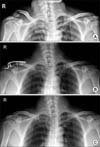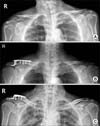Abstract
Purpose
The purpose of this study is to analyze the treatment results and complications in unstable distal clavicle fractures which were treated with a Hook plate, and, in particular, to compare the functional results before and after removal of the Hook plate.
Materials and Methods
We examined 20 cases in 20 patients who underwent removal of Hook plates after bony union was obtained in an unstable fracture of the distal clavicle (Neer type II) from March 2009 to December 2012. The average follow-up period after initial surgery was 12 months (8-20 months). Plates were removed at 18 weeks (ranged from 10-36 weeks) after initial fixation. University of California at Los Angeles (UCLA) and Korean Shoulder Scoring System (KSS) scores were used for clinical functional evaluation, and plain radiographs were used for radiological evaluation.
Results
In radiological evaluation, bony union was obtained at an average of 11.4 weeks (ranged from 8-14 weeks) in all of the 20 patients. All of the 20 patients showed limited range of motion, mild pain, and discomfort of the shoulder before removal of the Hook plate, and all of the 20 patients showed better results in UCLA and KSS score after removal of the plate, when compared to before removal. Stress fracture as a major complication, was united completely with a 'figure of 8' bandage and deep wound infection was resolved after repeated debridement and antibiotic treatment with satisfactory functional results.
Conclusion
Hook plate in treatment of unstable fracture of the distal clavicle is considered to be a useful method because rigid fixation can be obtained. However, there are some complications, such as limited range of motion, pain, and discomfort of the shoulder joint, before removal of the Hook plate. Therefore, we think that removal of the Hook plate as soon as possible if bony union is obtained would be desirable.
Figures and Tables
 | Figure 1(A) Neer type IIB fracture of the clavicle in a 53-year-old man is seen. (B) The distal clavicular fracture is stabilized with a Hook plate. (C) At postoperative three months, radiograph shows union of the fracture. |
 | Figure 2(A) Neer type IIA fracture of the distal clavicle in a 68-yearold man is seen. (B) Immediate postoperative radiograph shows normal cortical surface of acromion. (C) At postoperative three months, radiograph shows subacromial erosion around the tip of the Hook plate. |
References
1. Kim JH, Lee SC, Cho DY, Yoon HK, Lee YS. Percutaneus cerclage wiring in distal clavicle fracture type 2a-one case report. J Korean Shoulder Elbow Soc. 2006; 9:124–129.
3. Kashii M, Inui H, Yamamoto K. Surgical treatment of distal clavicle fractures using the clavicular hook plate. Clin Orthop Relat Res. 2006; 447:158–164.

4. Neer CS 2nd. Fractures of the distal third of the clavicle. Clin Orthop Relat Res. 1968; 58:43–50.
5. Nordqvist A, Petersson C, Redlund-Johnell I. The natural course of lateral clavicle fracture. 15 (11-21) year follow-up of 110 cases. Acta Orthop Scand. 1993; 64:87–91.

6. Flinkkilä T, Ristiniemi J, Lakovaara M, Hyvönen P, Leppilahti J. Hook-plate fixation of unstable lateral clavicle fractures: a report on 63 patients. Acta Orthop. 2006; 77:644–649.

7. Hackenbruch W, Regazzoni P, Schwyzer K. Surgical treatment of lateral clavicular fracture with the "clavicular hooked plate". Z Unfallchir Versicherungsmed. 1994; 87:145–152.
8. Lee KW, Lee SK, Kim KJ, Kim YI, Kwon WC, Choy WS. Arthroscopic-assisted locking compression plate clavicular hook fixation for unstable fractures of the lateral end of the clavicle: a prospective study. Int Orthop. 2010; 34:839–845.

9. Meda PV, Machani B, Sinopidis C, Braithwaite I, Brownson P, Frostick SP. Clavicular hook plate for lateral end fractures: a prospective study. Injury. 2006; 37:277–283.
10. Charity RM, Haidar SG, Ghosh S, Tillu AB. Fixation failure of the clavicular hook plate: a report of three cases. J Orthop Surg (Hong Kong). 2006; 14:333–335.

11. Eskola A, Vainionpää S, Pätiälä H, Rokkanen P. Outcome of operative treatment in fresh lateral clavicular fracture. Ann Chir Gynaecol. 1987; 76:167–169.
12. Faraj AA, Ketzer B. The use of a hook-plate in the management of acromioclavicular injuries. Report of ten cases. Acta Orthop Belg. 2001; 67:448–451.
13. Salem KH, Schmelz A. Treatment of Tossy III acromioclavicular joint injuries using hook plates and ligament suture. J Orthop Trauma. 2009; 23:565–569.

14. Chen CH, Chen WJ, Shih CH. Surgical treatment for distal clavicle fracture with coracoclavicular ligament disruption. J Trauma. 2002; 52:72–78.

15. Kim JS, Jun JH, Chung YK. Coracoclavicular screw fixation for AC dislocation and unstable distal clavicle fracture. J Korean Shoulder Elbow Surg. 1999; 2:133–137.
16. Neer CS 2nd. Fracture of the distal clavicle with detachment of the coracoclavicular ligaments in adults. J Trauma. 1963; 3:99–110.

17. Kao FC, Chao EK, Chen CH, Yu SW, Chen CY, Yen CY. Treatment of distal clavicle fracture using Kirschner wires and tension-band wires. J Trauma. 2001; 51:522–525.

18. Zenni EJ Jr, Krieg JK, Rosen MJ. Open reduction and internal fixation of clavicular fractures. J Bone Joint Surg Am. 1981; 63:147–151.

19. Fann CY, Chiu FY, Chuang TY, Chen CM, Chen TH. Transacromial Knowles pin in the treatment of Neer type 2 distal clavicle fracturesA prospective evaluation of 32 cases. J Trauma. 2004; 56:1102–1105.

20. Kona J, Bosse MJ, Staeheli JW, Rosseau RL. Type II distal clavicle fractures: a retrospective review of surgical treatment. J Orthop Trauma. 1990; 4:115–120.
21. Craig EV. Fracture of the clavicle. In : Rockwood CA, Green DP, Bucholz RW, Heckman JD, editors. Fractures in adults. 4th ed. Philadelphia: Lippincott-Raven;1996. p. 1109–1161.
22. Flinkkilä T, Ristiniemi J, Hyvönen P, Hämäläinen M. Surgical treatment of unstable fractures of the distal clavicle: a comparative study of Kirschner wire and clavicular hook plate fixation. Acta Orthop Scand. 2002; 73:50–53.

23. Chiang CL, Yang SW, Tsai MY, Kuen-Huang Chen C. Acromion osteolysis and fracture after hook plate fixation for acromioclavicular joint dislocation: a case report. J Shoulder Elbow Surg. 2010; 19:e13–e15.

24. Renger RJ, Roukema GR, Reurings JC, Raams PM, Font J, Verleisdonk EJ. The clavicle hook plate for Neer type II lateral clavicle fractures. J Orthop Trauma. 2009; 23:570–574.

25. Tambe AD, Motkur P, Qamar A, Drew S, Turner SM. Fractures of the distal third of the clavicle treated by hook plating. Int Orthop. 2006; 30:7–10.





 PDF
PDF ePub
ePub Citation
Citation Print
Print






 XML Download
XML Download